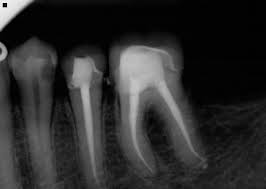In rare cases, root canal fails to work as expected. The infected tooth might remain infected or a patient might feel post-operative discomforts that threaten the survival of the tooth, but the truth is that a failing root canal doesn’t have to be a nightmare. A root canal redo can fix the problem. Redo of root canal involves the sectioning and removing of the existing crown and packing material, the cleaning and shaping of the root canals, and the re-filling of the roots and redoing the dental crown of the tooth. In short, redo of a root canal is very similar to the first root canal therapy, not considering the gutta-percha and crown removal. The rate of success for a root canal redo runs at about 75%. At Doctors Network, we get the value of finding a skilled endodontist, so we have made it painfully simple to find a local root canal specialist.
Root canal treatments and retreatments are a better alternative than tooth removal for most Brooklyn patients. If a tooth has a solid surface, good bone support, and healthy gums surrounding it, it has a good chance of being restored and saved. Choosing root canal redo in Brooklyn, NY is most likely far less expensive than the alternatives. Dental implant placement and aesthetically pleasing bridgework cost far more than keeping the original tooth. Additionally, they require maintenance and appear less aesthetically pleasing than a “natural” tooth.
Why is re-do of a root canal required?
Though the prospect of more endodontic therapy cannot pleasant, root canal re-do is fairly straightforward. Generally, the entire treatment can be completed in 1-3 appointments.
There are a number of reasons why root canal treatment suddenly fails, including:
- Delay in the placement of restorative devices after the root canal.
- Narrow or curved canals not filled during the first procedure.
- Cracked dental crown leaking filling material.
- New decay to the tooth.
- New crack in the tooth.
- Undetected complex root canal structures.
- Saliva entering the restorative structure.
If you experience these dental issues, please do not hesitate. Visit Doctors Network and find the ideal dental specialist for you to prevent damage to your gums and adjacent teeth.
On the day of the redo procedure, a local anesthetic will be injected for numbing the area, unless another type of anesthetic has been recommended. The affected tooth is isolated with a dental dam. The dam protects the tooth during retreatment from salivary bacteria. The extent of cleaning the endodontist can do on each visit depends upon the amount of infection present, and the irregularities of the canals.
The first challenge in root canal redo is to access to the root canals. If a prefabricated post and crown are in place, they will need to be removed first.
After that, any filling material and any obstructions that cover the root canals have to be removed. This excavation is usually conducted utilizing an ultrasonic handpiece. The upside of using this handpiece is that any unwanted material is vibrated loose. Tiny dental files will then be used to clean and shape the root canals. Dental X-rays may be taken to ensure that the rot canals are clean. If this step of the treatment proves to be challenging, medicated agents will be applied, and the remaining steps can be performed at the next visit.
When the dentist is confident that the root canals are completely clean, gutta-percha filling is used to pack the space. This rubbery material hermetically seals the root canals to prevent the regrowth of bacteria. Lastly, a provisional filling is used to cover the tooth. At a later visit, the porcelain permanent crown will be delivered.
If you have to get a root canal redo in Brooklyn, NY, or its neighborhoods such as Park Slope, Crown Heights, or Fort Greene, ask 1st Impression Dental, or its founder Dr. Pooria Shahin DDS.
